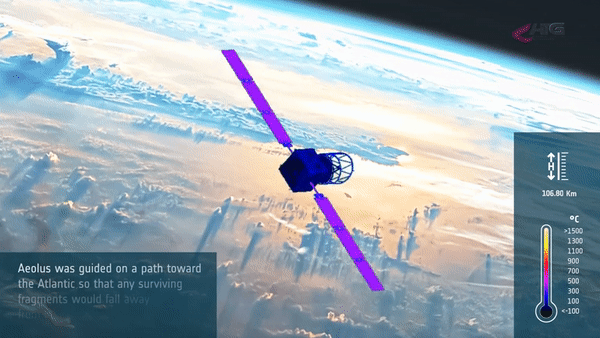Objects detected in the vicinity of ClearSpace-1 debris removal mission target
On 10 August 2023, ESA’s Space Debris Office was informed by the United States 18th Space Defense Squadron that new objects have been detected in the vicinity of a payload adapter.
This adapter, named VESPA, was left in orbit following the 2013 launch of a Vega rocket from ESA’s spaceport in Kourou, French Guiana. The object is a 113 kg, two-metre-diameter, conical upper portion of a payload adapter associated with the VV02 Vega launch that delivered the Proba-V, VNREDSat-1 and ESTCube-1 satellites into Earth orbit.
The new debris is believed to originate from the VESPA adapter, which is in an orbit with perigee at 660 km altitude, apogee at 790 km and an inclination of 98.72 degrees.
This payload adapter is the subject of the upcoming ClearSpace-1 active space debris removal (ADR) mission. It is being developed as the first-ever mission to remove an existing derelict object from orbit through highly precise and complex, close-proximity and capture operations.
ESA procured the Clearspace-1 mission as a service from the Swiss start-up ‘ClearSpace’ in order to demonstrate the technologies needed for debris removal and as a first step to establishing a new, sustainable and striving commercial space ecosystem.
The information currently available indicates that the most likely cause of the event was the hypervelocity impact of a small, untracked object that resulted in a low-energy release of new fragments. A preliminary assessment indicates that the increased collision risk to other missions posed by these fragments is negligible.
The US 18th Space Defense Squadron has conducted further tracking, and the TIRA system of the Fraunhofer Institute for High Frequency Physics and Radar Techniques in Germany and the Polish “European Optical Network” members (under ESA contract) have also conducted independent observations. These observations indicate that the main object remains intact and has experienced no significant alteration to its orbit.
The development of the ClearSpace-1 mission will continue as planned while additional data on the event is collected. ESA and industrial partners are carefully evaluating the event’s impact on the mission. A full analysis will last for several weeks.
This fragmentation event underlines the relevance of the ClearSpace-1 mission. The most significant threat posed by larger objects of space debris is that they fragment into clouds of smaller objects that can each cause significant damage to active satellites. To minimise the number of fragmentation events, we must urgently reduce the creation of new space debris and begin actively mitigating the impact of existing objects.















 Germany
Germany
 Austria
Austria
 Belgium
Belgium
 Denmark
Denmark
 Spain
Spain
 Estonia
Estonia
 Finland
Finland
 France
France
 Greece
Greece
 Hungary
Hungary
 Ireland
Ireland
 Italy
Italy
 Luxembourg
Luxembourg
 Norway
Norway
 The Netherlands
The Netherlands
 Poland
Poland
 Portugal
Portugal
 Czechia
Czechia
 Romania
Romania
 United Kingdom
United Kingdom
 Slovenia
Slovenia
 Sweden
Sweden
 Switzerland
Switzerland































